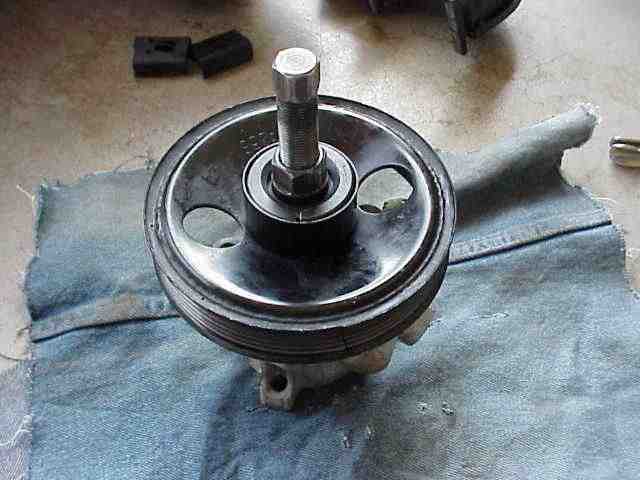Power steering pumps do not last for ever. Heat is one of the biggest enemies of your pump and its power steering fluid. You’ve probably heard your pump whining when it gets used heavily….a sign that it is certainly getting hot and worse, it may be getting near the end of its life. At over 60K miles, the factory power steering pump on my TJ was still going strong, even after years of pushing 35″ tires around. I know of friends who have replaced theirs with less miles than mine. My pump replacement came about as a result of my installing a Hydroboost brake system. My wrenchin’ buddy, MikeW, donated a day to help with the Hydroboost install. I’ve decided to split out the power steering pump portion of the project and write it up separately to make it easier for folks who need to do just a pump change out.
Replacing the pump is pretty straight forward. Remove the serpentine belt, remove the pump, install the new pump, replace the belt, bleed the pump, enjoy your power steering again. OK, maybe it is not quite that simple but give or take a little bit, it’s not much more difficult that that. If you have done other wrenching projects on your engine, such as an alternator or water pump replacement, you already have a pretty good idea of what this project will be like.
Before you get started on the replacement, do yourself a BIG favor and pick up a power steering pump pulley puller (yeah, say that 3 times really fast). I could not imagine trying to remove the pulley from the old pump without using one. I would NOT recommend using a conventional 3 jaw puller even though it would seem as though it would work. I am pretty sure the power steering pulley would warp/bend given its lightweight construction. The local AutoZone store rents specialty tools for free. You put down a deposit (it was $40 for the puller) using your credit card and when you return the tool, your card is credited back the deposit. Can’t go wrong on a deal like that.
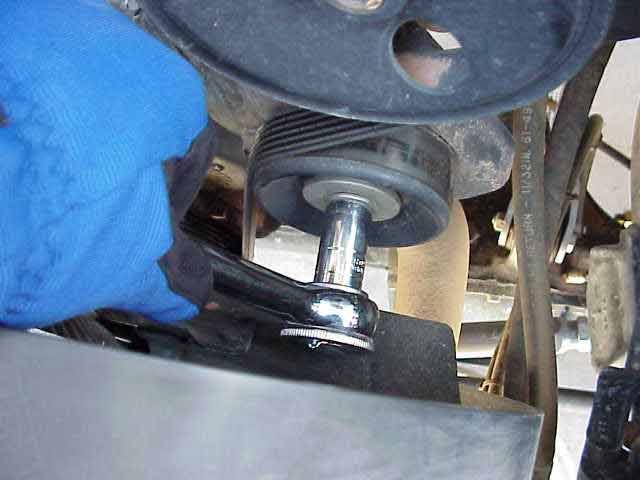
OK….to get started, you need to loosen the bolt that holds the belt tensioner pulley in place. Before doing so, note the tension of the belt (ie., how hard do you have to press to deflect the belt 1/2″). This will be helpful when you retention the belt later unless you have one of those cool tension gauges (which I don’t). The tensioner is located directly below the power steering pulley, as can be seen in the picture above. Loosen the bolt a couple of turns. The bracket that holds the tensioner and power steering pump as an adjusting bolt on it that changes the position of the tensioner pulley and thus the belt tension (the linked picture shows the bolt head with a red tinted box around it). Loosen the adjusting bolt until you can slip the serpentine belt from the power steering pulley. Note the routing of the serpentine belt to ensure it goes back correctly when the new pump nas been installed.
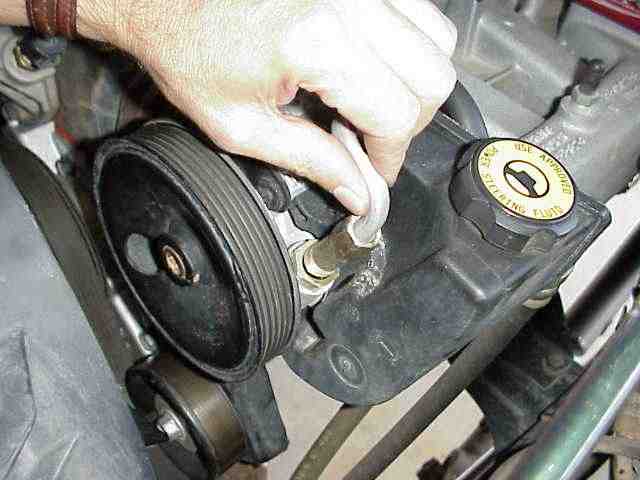
With the belt free of the pump pulley, loosen the high pressure line at the pump. I should mention that now is a good time to have a catch container handy and a wad of paper towels handy just in case it decides to dribble a bit. No one ever said these jobs were neat and tidy.

The pump is held in place by 3 long bolts that can be accessed through the hole in the pulley. As can be seen above, a short extension on the end of your ratchet will work nicely to remove the mounting bolts. Remove 2 of the bolts completely and leave the 3rd loose and holding the pump in place.
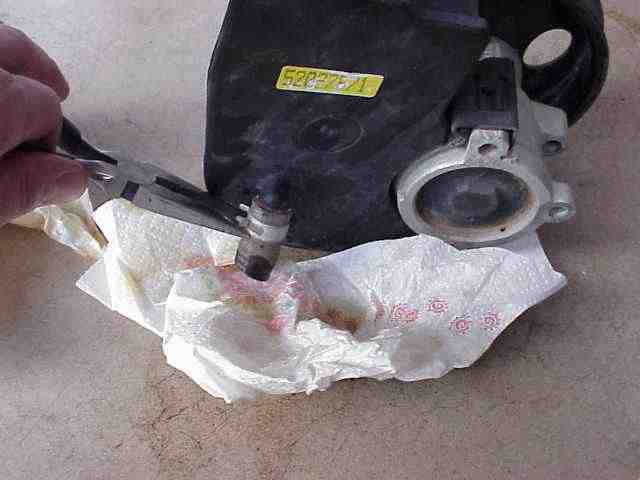
OK, we are now at a point where I will pass along my comments on the way I did my replacement because I took the advice of a good friend and the result means you may need to replace a hose. Not a biggie to do….just let me explain. In the above picture, the hose clamp I am removing is on the pump’s low pressure return line. As you can see, I cut the hose before I removed the pump from its mounting bracket. The reasoning behind this destructive removal? My buddy was replacing his pump some time ago and he did what anyone would normally do when he got to the return line….remove the hose clamp and then twist the hose a bit to break it loose from the fitting before trying to pull the hose off. When he twisted the hose, the fitting broke off of the reservoir (after all, it is plastic) . DOH! Purchasing a replacement reservoir by itself does not seem to be an option at this point in time so one is forced to purchase the pump/reservoir as a unit. As for me, my new pump did not have a reservoir with it. If your pump comes with one (they are available that way for about $15 more than just the pump), then you can probably disregard my words of caution and proceed as one normally would with removing the hose. If it breaks the fitting, no biggie, you already have a new reservoir to replace it. If you don’t break the fitting, you have a spare reservoir that you can sell to some unfortunate person who did it the way my buddy did. On my ’98, the low pressure return hose is an 11/32″ diameter hose and is NOT molded into the fitting it attaches to on the steering gearbox (it has a hose clamp there as well). While I had a new section of 3/8″ hose (close enough fit) on hand for just this situation, it is also possible that the factory hose had more than an inch of slack in it and cutting off that little bit would not have made any difference (I didn’t bother to check). So there is the explanation and you have the reasons and facts now to make your own decision as to how you want to handle the return hose where it connects to the reservoir.
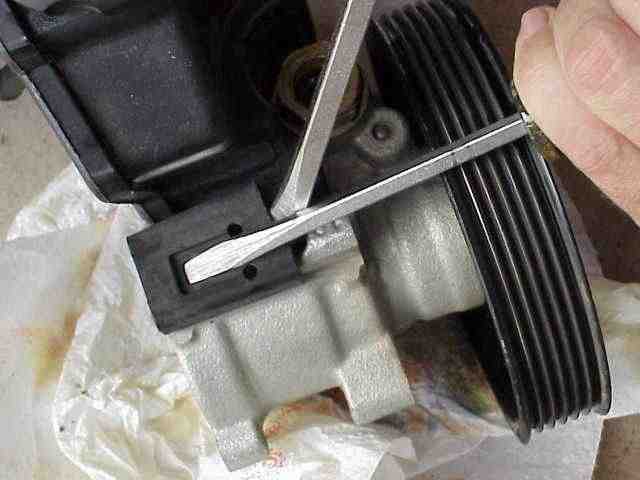
With the pump now removed from the mounting bracket and the return hose issue taken care of, I needed to separate the reservoir from the pump body. There are two metal clips that hold the reservoir in place. A couple of screw drivers were used to remove them….one to pry the locking clip out of the way while the other was used to push the metal clip off of the pump body.

With the metal clips removed, I carefully separated the reservoir from the pump body. A small neck on the reservoir fits down into an opening on the pump body. There is an o-ring that seals the connection between the pump and the reservoir. The factory service manual states that a new o-ring should be used for reassembly. I did not replace the o-ring and have had no subsequent leaks because of it. Had I done my homework a little better, I would have had a new one on hand. (I didn’t feel like stopping the project to go run down an o-ring so I recycled the existing one.)
Power Steering Pump Replacement
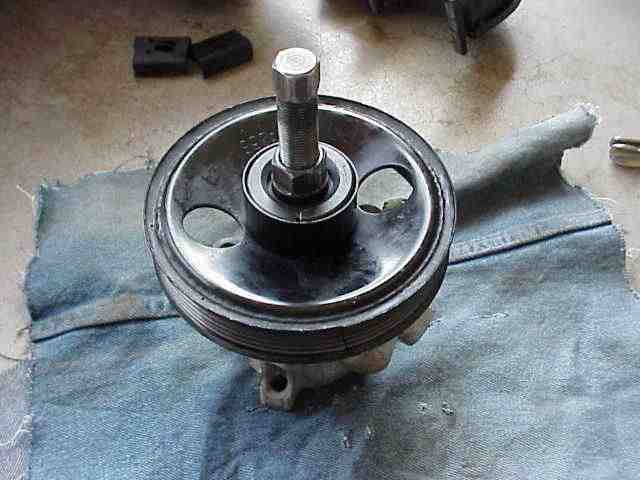
With the reservoir now removed from the pump body, Mike and I opened up the plastic box that held the power steering pump pulley puller. No instructions were in it but it wasn’t that difficult to figure out. The pulley has a collar right where it fits over the pump shaft. The puller engages this collar and a large bolt, as shown in the above picture, pushes against the pump shaft which pulls the pulley off of the shaft. Here is a more detailed explanation of using the pulley remover.
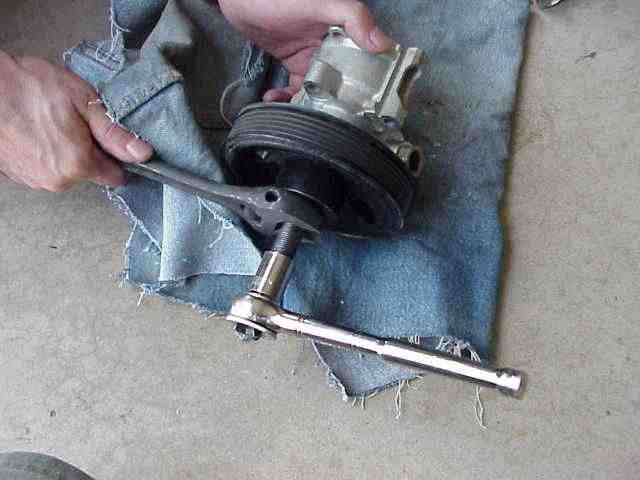
As seen in the above photo, one holds a nut in place while screwing the bolt into it which pushes the shaft out of the pulley’s hub. I was surprised when I realized that the pulley is held onto the pump shaft with just a friction fit. The paperwork that came with the pump said it is possible that your pulley can be stretched and so will not reliably fit on the shaft when you assemble it on the new pump. Although not shown in the above picture, we used my cheapo 12V electric impact wrench to initially get the pulley broken loose.. Mike had never seen me used it but it did the job sufficiently and we were able to break the pulley loose after 45 seconds of the little impact wrench smacking the daylights out of that big bolt. We finished up pushing the pump shaft out of the pulley with a ratchet. Once it gets started, it goes pretty good. It would NOT have been a fun job trying to get it broken loose had it not been for the impact wrench. Holding that pulley while putting the lean on that socket, even with a big breaker bar, would have been difficult.
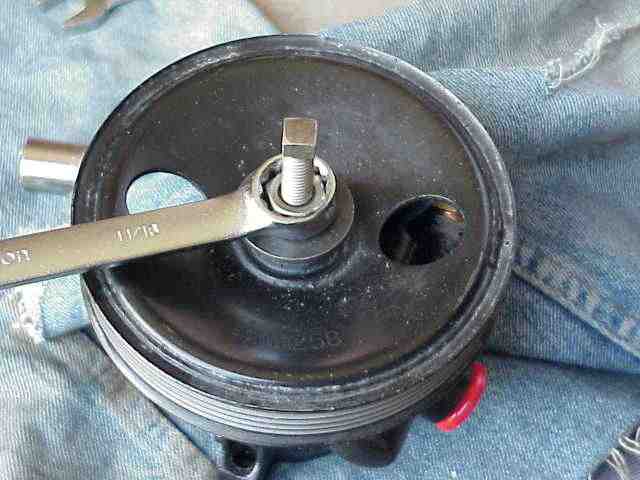
The new pump came with a bolt, nut, and washer that together made up the power steering pump pulley installer tool. It is pretty straight forward. The pump shaft has a tapped hole in it that the bolt, as shown above, is threaded in to. By holding the head of the bolt and tightening the nut, the nut and washer force the pulley down onto the pump shaft. You simply tighten the nut until it stops, at which time the pulley has been seated flush onto the pump shaft. This is the step were you would notice if you had a stretched pulley as it would slide onto the shaft very easily (or it would simply be a sloppy fit).
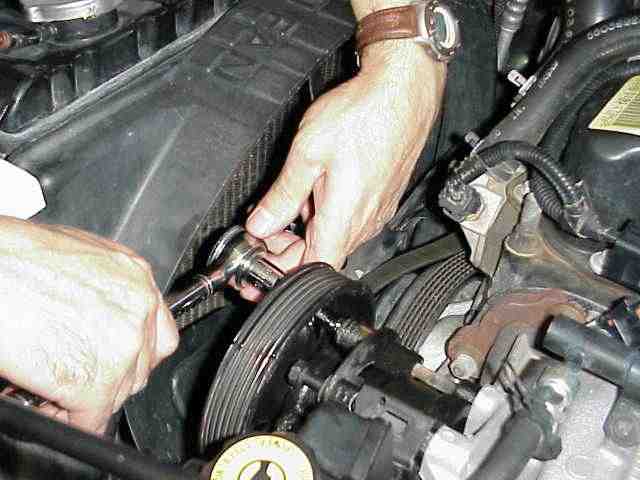
At this point, you basically reverse the steps you took while removing the pump. Carefully seat the reservoir into the pump body and reattach the two metal clips that hold these two pieces together. Mount the pump body to the bracket using the three bolts. Route the serpentine belt around the pump pulley and adjust the belt tension. Don’t forget to tighten the bolt in the middle of the tensioner pulley when you are done with this step. Install the high pressure line at the pump body. Note that your pump may come with replacement o-rings (very small) that fit on the high pressure pump fitting. As I was going to use a different high pressure line, I didn’t need the o-rings but if you are simply doing a pump replacement without any other changes, follow the pump manufacturers directions concerning the replacement of the o-rings, assuming they supply them.
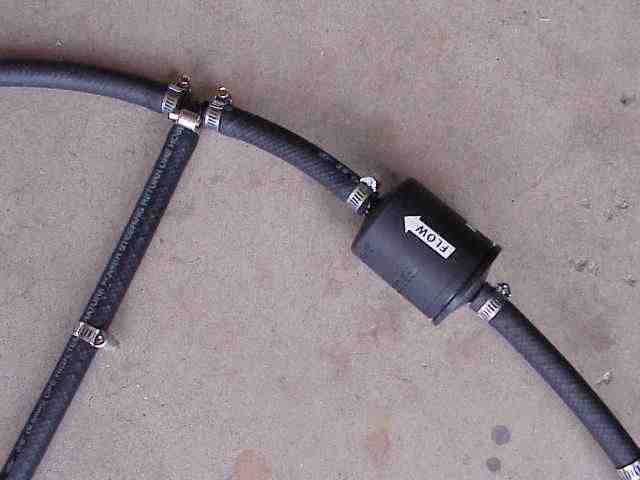
My pump came with a filter. I’ve never seen a power steering pump filter before but as you can see in the above picture, there it is. Although mentioned in my pump literature, I believe the Hydroboost vendor was responsible for including it in the kit. Regardless, it sure seems like a good idea and would certainly be a no brainer if you actually had a pump failure and there was a chance of having contaminates (metal filings, etc.) in the system. Disregard the hoses in the above picture as it is part of the Hydroboost hoses that are supplied with the system. The filter is installed in the low pressure return line. Just note the direction of the fluid flow and match the big arrow on the filter to the fluid flow.
With the filter installed and the remaining hose clamps tightened, it was time to bleed the air from the power steering system. I’ll confess that the addition of the Hydroboost and several extra feet of hose introduced a significant amount of trapped air in my system. A regular pump replacement should not cause quite as much air in the system, but you will have some.
The literature that came with my power steering pump included steps for bleeding the system. Assuming your replacement pump does too, I would recommend you follow them. If all you got in your pump’s shipping box was the pump, you will probably do just fine if you follow the method I used.
Fill the reservoir with the vehicle manufacturer’s recommended power steering fluid and let it set UNDISTURBED for a few minutes while you recheck your work (hose fittings, clamps, mounting bolts, etc.) Wipe down the pump body, reservoir, and fittings so that any fluid leak can be easily detected. I filled the reservoir to within about 3/4″ of the top, which was just about right. While bleeding mine, there were several times when the fluid would rise and fall within the reservoir and had it been fuller, it would have bubbled out of the top and contributed to the mess I was trying to avoid.
Raise the front of the vehicle and support the axle (small jack stands are perfect for this) so that the tires miss touching the ground. WITHOUT STARTING THE ENGINE, slowly begin to cycle the steering wheel. The word SLOWLY is important….it means about 1 revolution of the wheel every 8~10 seconds. Continue to add fluid to the reservoir as necessary. While Mike and I slowly worked the steering wheel back and forth, the fluid level would rise and fall and then we would have to add some more. Finally, the fluid level barely changed as we turned the wheel from stop to stop and it seemed as though we had gotten the bulk of the air out of the system.
We looked for any signs of leaks and finding none, we started the engine. There was a little bit of growling from the power steering system but it was not that noticeable (I’ve heard worse in Jeeps that were out on the trail). With the engine at about 1200 RPM, slowly cycle the steering wheel in both direction, lightly contacting the wheel stops. Continue to check fluid level and add if necessary. Note that there are fill marks on the reservoir cap’s dip stick. If the pump begins to get noisy, turn the engine off and let the system set for about 15 minutes. Air in the system will cause the pump to groan and the fluid level will rise when the engine is turned off. Lots of tiny bubbles in the reservoir is a good sign of trapped air in the system. Repeat the above steps until your power steering is operating normally.
My newly installed power steering pump was pretty much bled free of air on the first attempt. We turned off the engine one time and let it sit for a bit, then slowly cycled the steering wheel and added a bit of fluid. The 2nd time we started the engine, the pump sounded fine, no whining, and no bubbles in the fluid. Remove the jack stands from the front axle and take it for a test drive.
That’s it! If all went according to plan, you are now the proud owner of a newly installed power steering pump…and you saved yourself significant bucks by doing it yourself! And the best part is that you did the work yourself and that you know it was done correctly.
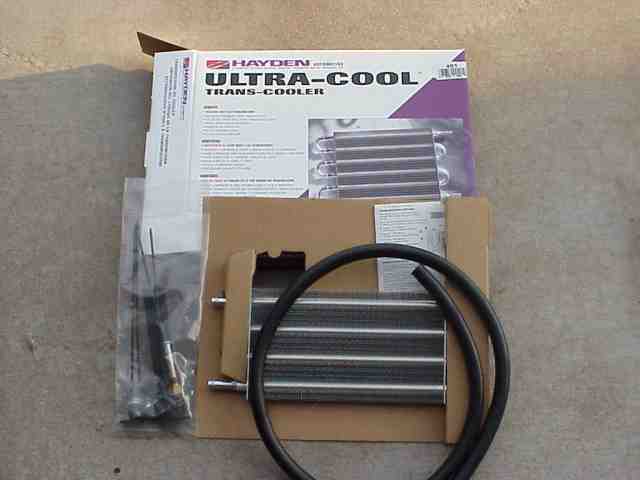
Mike and I ran out of time when we were doing the Hydroboost install. It was, and still is, my intention to install a small automatic transmission cooler in the low pressure return line coming out of the steering gear box. As I mentioned before, heat and power steering fluid does not play well together. I plan on giving my newly installed pump the best chance I can towards a long and productive life. You should find a write-up covering the above cooler install fairly soon.
Good wrenchin’ and remember to TREAD Lightly!

